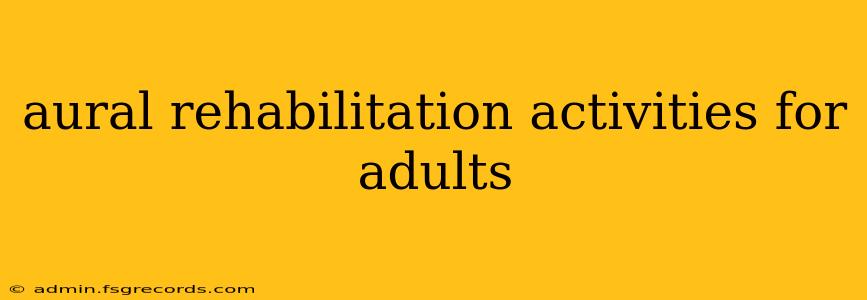Hearing loss significantly impacts an adult's quality of life, affecting communication, social interaction, and overall well-being. Aural rehabilitation plays a crucial role in mitigating these effects, empowering individuals to manage their hearing loss and improve their communication skills. This post explores various aural rehabilitation activities specifically tailored for adults, emphasizing practical strategies and techniques.
Understanding the Goals of Aural Rehabilitation
Before diving into specific activities, it's essential to understand the primary goals of aural rehabilitation for adults:
- Improved Communication Skills: Enhancing the ability to understand speech in various listening environments, including noisy settings.
- Enhanced Listening Strategies: Developing techniques to optimize hearing and communication, such as focusing on the speaker's lip movements.
- Increased Self-Confidence: Building confidence in communicating and participating in social situations.
- Reduced Hearing-Related Stress: Minimizing the emotional toll associated with hearing loss, including frustration and isolation.
- Improved Quality of Life: Enhancing overall well-being and participation in daily life activities.
Key Aural Rehabilitation Activities for Adults
A comprehensive aural rehabilitation program typically involves a combination of approaches. Here are some key activities:
1. Auditory Training Exercises
These exercises focus on improving the ability to discriminate between sounds, recognize speech in noise, and understand different speakers. Examples include:
- Phoneme Discrimination: Identifying subtle differences between similar-sounding speech sounds (e.g., /b/ and /p/).
- Speech Recognition in Noise: Practicing understanding speech in the presence of background noise, often using recorded materials or simulated environments.
- Auditory Closure Training: Filling in missing parts of words or sentences based on context and other auditory cues.
2. Communication Strategies Training
This component emphasizes practical techniques to optimize communication in everyday situations. Examples include:
- Speaker Strategies: Learning to effectively communicate needs and preferences to hearing partners, such as asking for clarification or repetition.
- Listener Strategies: Developing active listening techniques, such as focusing on the speaker's face, using visual cues, and employing conversational strategies.
- Environmental Modifications: Identifying and adjusting environmental factors that impact communication, like reducing background noise or optimizing seating arrangements.
3. Tinnitus Management Techniques
For individuals experiencing tinnitus (ringing in the ears), aural rehabilitation programs often include strategies to manage this distressing symptom. These may include:
- Sound Therapy: Using white noise generators or other sound masking devices to reduce the perception of tinnitus.
- Cognitive Behavioral Therapy (CBT): Addressing the emotional and psychological impact of tinnitus through therapy techniques.
- Relaxation and Stress Reduction Techniques: Employing strategies like deep breathing exercises and meditation to alleviate tinnitus-related stress.
4. Assistive Listening Device (ALD) Training
Many adults with hearing loss benefit from using ALDs, such as hearing aids, cochlear implants, or FM systems. Training is crucial to ensure proper use and maximize the benefits.
5. Speech Reading (Lip Reading) Training
Speech reading involves understanding speech by observing lip movements and facial expressions. Training sessions focus on recognizing phonetic variations, improving visual perception skills, and integrating auditory and visual information.
6. Social Communication Skills Training
This often overlooked aspect of aural rehabilitation focuses on building confidence and improving social interaction. Activities might include:
- Role-Playing: Practicing real-life communication scenarios in a safe and supportive environment.
- Group Communication Activities: Participating in group discussions to improve communication skills in social settings.
- Support Groups: Connecting with other individuals who have hearing loss, offering mutual support and shared experiences.
Finding Aural Rehabilitation Services
Many audiologists and speech-language pathologists offer aural rehabilitation services. It's crucial to find a qualified professional with experience in working with adults experiencing hearing loss. They can provide personalized assessments, develop tailored rehabilitation plans, and monitor progress.
Conclusion
Aural rehabilitation is an ongoing process that requires commitment and consistent effort. By engaging in these activities and working closely with a healthcare professional, adults with hearing loss can significantly improve their communication abilities, boost their self-confidence, and enhance their overall quality of life. Remember, reclaiming hearing health is a journey, and consistent effort yields significant rewards.

